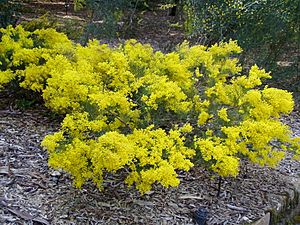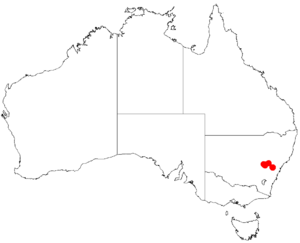Acacia meiantha facts for kids
Quick facts for kids Acacia meiantha |
|
|---|---|
 |
|
| Conservation status | |
| Scientific classification | |
| Genus: |
Acacia
|
| Species: |
meiantha
|
 |
|
| Occurrence data from AVH | |
Acacia meiantha is a special kind of flowering plant, a shrub, that belongs to the pea family, called Fabaceae. It's found only in a small part of eastern Australia. This plant is quite rare and was officially listed as an Endangered species in 2018. This means it needs protection to survive.
What it Looks Like
The Acacia meiantha shrub usually grows straight up, but sometimes it can spread out. It can reach a height of about 1.5 to 2.5 m (4 ft 11 in to 8 ft 2 in) (about 5 to 8 feet tall). This plant often spreads by sending out new shoots from its roots, which is called suckering. Its bark is smooth and can be greenish-brown, grey, or light brown. The young branches are angled and have tiny hairs.
Like most plants in the Acacia group, it doesn't have true leaves. Instead, it has special flattened stems called phyllodes that look and act like leaves. These phyllodes are packed closely together and are smooth (meaning they are glabrous). They stay green all year round. They are usually straight or slightly curved, measuring about 1 to 6.5 cm (0.39 to 2.56 in) long and 0.4 to 1 mm (0.016 to 0.039 in) wide. They have a faint line down the middle.
This plant blooms between July and October, showing off bright yellow flowers. The flowers grow in simple groups called inflorescences. These groups are found in clusters of 2 to 19 along the branches. Each flower-head is round, about 3 to 5 mm (0.12 to 0.20 in) across, and contains four to eight yellow or dark yellow flowers. After the flowers bloom, flat, papery or thin, leathery seed pods form. These pods are smooth and can be straight or slightly curved. They are about 2.7 to 8.5 cm (1.1 to 3.3 in) long and 4 to 7 mm (0.16 to 0.28 in) wide.
How it Got its Name
Scientists Mary Tindale and C.Herscovich first officially described this plant in 1992. They published their findings in a science journal called Australian Systematic Botany. The plant's specific name, meiantha, comes from Greek words meaning "few flowers." This is because its flower-heads have only a small number of flowers. For a short time in 2003, a botanist named Leslie Pedley reclassified it, but it was moved back to the Acacia group in 2006. The phyllodes of Acacia meiantha look similar to those of Acacia linifolia and Acacia boormanii.
Where it Lives
Acacia meiantha has a very small natural range. It is found in the Great Dividing Range in New South Wales, Australia, specifically around Clarence and Mullions Range. It grows in dry sclerophyll forests or woodlands. These are types of forests with tough, hard-leaved plants that can survive dry conditions. The plant prefers to grow in clay or sandy soil.
Its total living area is estimated to be only about 68 km2 (26 sq mi). The groups of plants are very spread out and broken up, and their numbers are decreasing. There are three separate groups of these plants located on the Central Tablelands, each within 100 km (62 mi) of the others.


